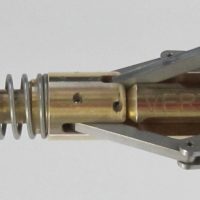Description
What is Core Orientation?
Core orientation is the process of marking the orientation of drill core sample for analysis, with regard to its original position after it has been removed from the ground. Depth and azimuth are rightly regarded as important indicators of core position. These on their own however, are generally inadequate to determine the original aspect of;
- faults
- cleavages
- joints
- schistosity
- mineral lineations
- slickenslides
- lithological contacts
The orientation of the core, that is, which side of the core was facing the bottom (or top) of hole will enable the Geologist to establish these details.
Traditionally core orientation has been most effective on non-vertical (inclined) holes, but recent developments have made accurate core orientation possible in true vertical holes – see Vertical Borehole Core Orientation below.
Core orientation must be recorded during the drilling process. The analysis is then undertaken during normal core logging. The core logging process requires the use of an instrument to measure the alpha and beta angles of the geological features such as a goniometer or Ezylogger™.
Direct Measurement by rotating the core until the surface to be measured appears to make a maximum angle with the core axis. This procedure is the easiest method.
Why is recording & interpreting core orientation important?
It allows Exploration Geologists and Geophysical Engineers to understand the geology of an area & make decisions about the future of the site based on the results of the exploration.
In the mining industry, this can impact a range of issues, from overall economic feasibility, to ore body volume, to mine design & layout.
In the construction industry, core orientation can reveal important information about the geology that will impact on the design of foundations for buildings and other structures; for example the Freedom Tower construction site in New York (Ground Zero – formerly the World Trade Centre).
In the hydro-electrical power industry, knowledge of the underlying rock formations is critical for the design and construction of the dam walls, spillways and turbine based power stations.
How is core orientation achieved?
Various systems have been, and are currently, available to record core orientation. These include traditional systems such as the Spear and Clay Impression, and more recent systems such as the Ezy-Mark™.
For more information on how drill core is orientated go to AIG Handbook 5 (2nd Edition) “Structural Logging of Drill Core” – Roger Marjor ibanks
The Ezy-Mark™ is a mechanical orientation tool located at the front of the inner tube that can provide an audit-able impression of the hole bottom before drilling commences.
Other orientation tools are available (both electronic and mechanical), that are located at the back end of the inner tube and require the orientation reading to be transferred to the front before emptying the core into the core tray.
Who uses core orientation tools?
Drill rig operators generally use the tools as part of their drilling tasks.
What are key consideration for core orientation systems
- Minimal interruption to the drilling cycle
- Cost effectiveness
- Regular readings
- Accurate orientations
- Effective in a broad range of ground types and core breaks
- Orientation marks relate to the run of core drilled
- Can be used us up or down hole
- Single stage process t determine orientation position
- Option f an accurate, permanent record to be referred to a a later time.
- Audit-ability – the geologist must be sure the core orientation is correct and have procedural check in place for confirmation





